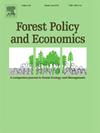亚马逊森林产品足迹趋同:ACTO国家的面板数据分析
IF 3.8
2区 农林科学
Q1 ECONOMICS
引用次数: 0
摘要
本研究考察了1961 - 2022年亚马逊合作条约组织(ACTO) 7个成员国森林产品足迹(FPF)的趋同性。这项研究调查了这些共享亚马逊雨林的国家的FPF水平是趋同还是分化。采用面板单位根检验,考虑平滑和尖锐的结构断裂,该研究确定了收敛和发散模式。哥伦比亚、厄瓜多尔和圭亚那显示出趋同的迹象,这可能是由保护政策和土著土地管理推动的。相反,巴西和秘鲁表现出差异,可能受到广泛的农业、采矿业和国际林产品贸易的影响。研究结果强调了ACTO内部协调区域政策的必要性,以促进可持续森林管理实践,解决不同的国家利益,并优先考虑亚马逊地区的环境保护。本文章由计算机程序翻译,如有差异,请以英文原文为准。
Forest product footprint convergence in the Amazon: A panel data analysis of ACTO countries
This study examines the convergence of forest product footprints (FPF) among seven Amazon Cooperation Treaty Organization (ACTO) countries from 1961 to 2022. The research investigates whether FPF levels are converging or diverging across these nations, which share the Amazon rainforest. Employing a panel unit root test that accounts for smooth and sharp structural breaks, the study identifies both convergence and divergence patterns. Colombia, Ecuador, and Guyana show evidence of convergence, potentially driven by conservation policies and indigenous land management. Conversely, Brazil and Peru demonstrate divergence, likely influenced by extensive agriculture, mining, and international trade in forest products. The findings emphasize the need for coordinated regional policies within ACTO to foster sustainable forest management practices, address divergent national interests, and prioritize environmental conservation in the Amazon.
求助全文
通过发布文献求助,成功后即可免费获取论文全文。
去求助
来源期刊

Forest Policy and Economics
农林科学-林学
CiteScore
9.00
自引率
7.50%
发文量
148
审稿时长
21.9 weeks
期刊介绍:
Forest Policy and Economics is a leading scientific journal that publishes peer-reviewed policy and economics research relating to forests, forested landscapes, forest-related industries, and other forest-relevant land uses. It also welcomes contributions from other social sciences and humanities perspectives that make clear theoretical, conceptual and methodological contributions to the existing state-of-the-art literature on forests and related land use systems. These disciplines include, but are not limited to, sociology, anthropology, human geography, history, jurisprudence, planning, development studies, and psychology research on forests. Forest Policy and Economics is global in scope and publishes multiple article types of high scientific standard. Acceptance for publication is subject to a double-blind peer-review process.
 求助内容:
求助内容: 应助结果提醒方式:
应助结果提醒方式:


